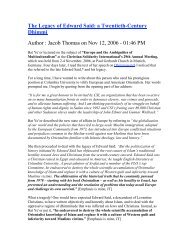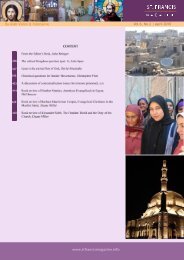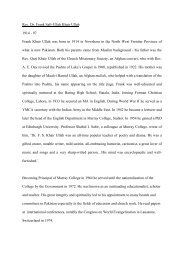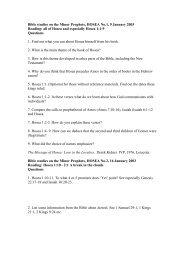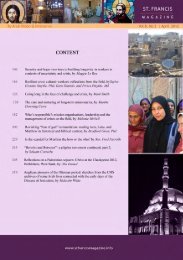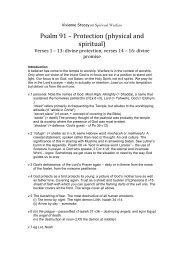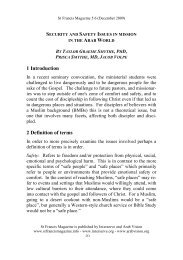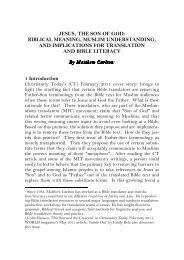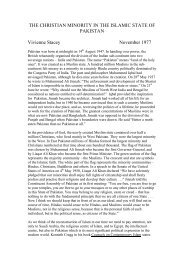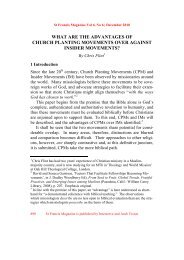download the pdf - St.Francis Magazine
download the pdf - St.Francis Magazine
download the pdf - St.Francis Magazine
You also want an ePaper? Increase the reach of your titles
YUMPU automatically turns print PDFs into web optimized ePapers that Google loves.
<strong>St</strong> <strong>Francis</strong> <strong>Magazine</strong> Vol 8, No 4 | August 2012<br />
wise, <strong>the</strong> future remains unknown (<strong>St</strong>etzer 2010c: 252). Different<br />
forms of contextualisation might well be appropriated more by second-generation<br />
believers (JdO 2010). At <strong>the</strong> same time, indigenous<br />
Christians need to be able to (and enabled to) critique past and present<br />
ways in which Christian mission has engaged <strong>the</strong>ir culture, as<br />
Priest observes in Gill (2009: 184).<br />
In closing, <strong>the</strong>refore, <strong>the</strong> reception or non-reception of C5 and<br />
insider movements will tell us important things about not just o<strong>the</strong>rs,<br />
but also ourselves. We also need to reflect critically on our situated<br />
point of view: from a distance, contextualisation or syncretism<br />
in o<strong>the</strong>rs might appear very clear, dualistically so, whereas from<br />
within a locale, <strong>the</strong> same issues might be more blurred, sophisticated,<br />
ambiguous, complex, or messy (Ridgway, in Gill 2009: 181; cf.<br />
also Gill 2008: 6; and, differently, Ajaj 2010). And so, proximity<br />
does not in and of itself confer clarity. Ridgway suggests that scriptures<br />
in an indigenous language are an essential precursor to contextualisation;<br />
so, too, is a willingness on <strong>the</strong> part of Western Christians<br />
to not expect unfairly or xenophobically more of MBBs than is<br />
expected culturally of converts in <strong>the</strong>ir own secular, materialist cultural<br />
settings (Mallouhi 2009: 7-10; Richard 2009: 179-180). Nor<br />
should any church anywhere remain unchanged by its contact with<br />
Muslim peoples (Hoefer 2009). We begin an analysis of insider<br />
movements from a different position if we assume that any denomination<br />
or congregation is syncretistic in its worldview to some degree,<br />
such that syncretism is <strong>the</strong> norm to be confronted also in ourselves,<br />
not <strong>the</strong> simply aberrant exception, <strong>the</strong> O<strong>the</strong>r (cf. Kim 2006:<br />
24). Even this assumption, however, is never neutrally held (cf.<br />
Winter 2008). Likewise, some degree of extraction – and of insertion<br />
– is similarly unavoidable in following Jesus. These issues need<br />
to be faced among different Muslim ministries, especially between<br />
higher- and lower-spectrum individuals, ministries and congregations<br />
living in close proximity to each o<strong>the</strong>r (cf. Ayub 2009: 31-32).<br />
Given vast diversities of local lived experience within insider<br />
movements, <strong>the</strong> C-scale helps describe and compare, but does not in<br />
itself legitimate or critique. Nor does it adjudicate on how high a<br />
tolerance for apparent contradiction is appropriate within frontier<br />
<strong>St</strong> <strong>Francis</strong> <strong>Magazine</strong> is a publication of Interserve and Arab Vision 496




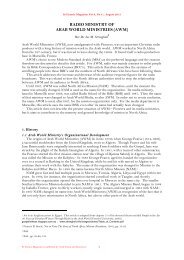
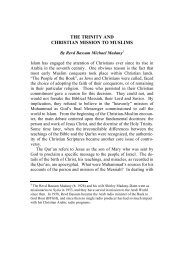
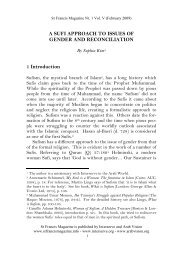
![Reflections on Surah Fatiha and the Lord's Prayer[1] - St.Francis ...](https://img.yumpu.com/49377951/1/184x260/reflections-on-surah-fatiha-and-the-lords-prayer1-stfrancis-.jpg?quality=85)
